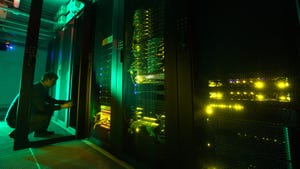
Insight and analysis on the data center space from industry thought leaders.
The Ergonomic Data Center: Save Us from Ourselves
While no design may be foolproof, there a few things that you should be looking for to help reduce the likelihood of those “oh s**t” moments that can ruin everyone’s day in the blink of an eye, writes Chris Crosby of Compass Datacenters.
March 5, 2014
Chris Crosby is CEO of Compass Datacenters.

chris-crosby-tn
CHRIS CROSBYCompass Datacenters
I recently saw a study on data center failures that found that the vast majority of outages are due to human error. Although it’s nice to have some numbers to back up the assumption, was anybody really surprised? After all, we are only human and, as a result, we make mistakes. Usually not on purpose mind you, but sometimes even our best efforts can result in some degree of mayhem. No one wants to be the one to bring an entire facility to its knees, but obviously the most common explanation in a service interruption post-mortem is usually “who” and not “why”. Since we know that we are our own worst data center enemies, doesn’t it seem like someone would start designing these things to help reduce the margin for “human error”?
While no design may be foolproof, there a few things that you should be looking for to help reduce the likelihood of those “oh s**t” moments that can ruin everyone’s day in the blink of an eye. Providing front access to equipment to make it easier to maintain is something to insist on. Having to service a CRAH should not require the average technician to possess the flexibility of a member of the US woman’s gymnastic team. Those girls are all about 12 years old and four feet tall, the average data center professional is…well, a little older, bigger and vaguely remembers the day he could touch his toes. Thus front access should be standard feature in your data center, for reliability certainly, but also out of pure human compassion.
Data centers by definition are complex environments. Finding and correcting problems within a jungle of conduit that would have forced Stanley to leave Dr. Livingstone to fend for himself is not the best way to ensure efficient maintenance and the quick resolution of issues when they arise. All of your conduit should be color coded and labeled. Not only would it make navigating through the facility a lot easier, it also looks pretty cool. I think we can all agree that anytime you can marry ergonomics and visual appeal, you’ve got a winning combination.
It might also be a nice touch for your data center provider to provide you with a detailed written Operating Procedures and Sequence of Operations and settings before they turn it over. Although you’d think that this would be a given, most data center customers get the equivalent of a couple of paper clipped pages documenting their new facility along with the keys to the joint upon turnover. On the job training and trial and error are both effective tools for learning in the right environment, unfortunately your new data center isn’t one of them. Let’s face it, when your new car comes with more documentation that your multi-million dollar data center, you’ve got a problem.
I guess the fundamental question here is why aren’t data centers designed with their users in mind? If human error is the biggest obstacle to data center reliability then build facilities that minimize that potential. In the near future more customer oriented, ergonomic features that reduce the possibility for human error will undoubtedly become standard requirements, if not for merely for the sake of reliability but to help save us from ourselves.
Don’t Put That There
If you’ve ever watched some of the house hunting shows on TV you know that a lot of homes don’t subscribe to what most of us would feel are the standard rules of design. For example, I’ve seen houses that required their owners to reach bedrooms by passing through others, hallways that can only be navigated by moving sideways, and patios populated by all manner of appliances. Data centers tend to be like some of these homes.
The reasons for this user unfriendliness are pretty straightforward. In multi-tenant environments, the goal of providers is to maximize the area of rentable raised floor. All other considerations thus become tangential, so necessary, but non-revenue producing elements, are located wherever they can be accommodated. For those of you familiar with this rationale, this should help answer the question of “why I need a map to find the POP room?” The rationale for the architectural idiosyncrasies of pre-fabricated solutions—It’s a 12-foot by 40-foot box—provides little solace when you’re carting boxes of new servers through the facility to “your data center.”
Since data centers are far from static environments, and activities like performing moves/adds/changes and unboxing and staging new hardware are regular events, you should insist that your provider use tighter guidelines than “within the same zip code” in locating site features like the loading dock and storage and staging facilities. Unfortunately, “user friendly” doesn’t seem to have made it past the white board stage for most data center designs.
While attributes like a low PUE, and the type of fire suppression system used are certainly important customer considerations, ergonomics is going to become more important to address the increasingly dynamic data center environment. Data centers that facilitate the ease of customer operations are the next logical step within the industry, albeit to the detriment of providers whose architectures reflect their requirements and not their customers.
Industry Perspectives is a content channel at Data Center Knowledge highlighting thought leadership in the data center arena. See our guidelines and submission process for information on participating. View previously published Industry Perspectives in our Knowledge Library.
About the Author
You May Also Like



.jpg?width=300&auto=webp&quality=80&disable=upscale)





